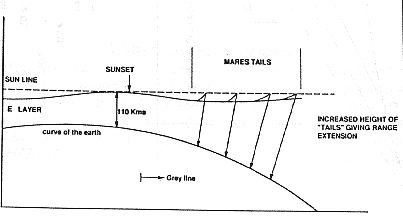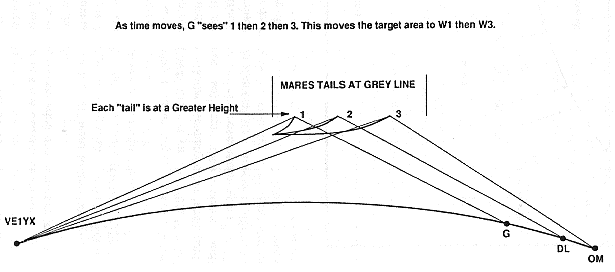

home > archive > propagation theory > E-layer and Sporadic-E

Thanks to all of our authors since 1982!
|
two
modes of propagation at 50MHz |
||
|
From these observations I have come to the conclusion that for
many years we have been too readily applying old ideas that,
whilst working well on HF and fitting the models of propagation
at those frequencies, do not always work at 50MHz and above.
The "Sporadic" openings are usually characterised by the following...
The old rule of HF Sporadic E states that as the skip
shortens, the MUF must rise (e.g. if the skip is short on 28 or
50MHz the MUF could be at 144MHz). I believe this to be largely
false. From my observations, when Sporadic E is present the same
target zone from a given location is present at all frequencies
up to the MUF/MOF. (opening on 12/06/93 with OK on 28/50/144MHz
or 12/05/93 with SV on 50 & 144). With E layer propagation it
would appear that the rule is valid - most obvious when the
signals to North America decline, if not disappear on 28MHz, at
the times when the band opens on 50MHz, much the same as F layer
propagation. I believe that we are, for the most part, unable to
see (hear) the E layer propagation, which is bringing in the weak
long range signals due to the very strong Sporadic E signals that
are masking them. There are exceptions to this, giving us a clue
to what is occurring. One of these events is the occurrence over
the last few years (totally due to the fact that amateurs are now
QRV) of the path to 9K, which is workable through the QRM from
I/YU etc. Other openings are those deep into Russia (mainly TV),
North America, the openings to the Caribbean and those to ZD8.
The last three have the advantage of not too many intermediate
areas of high density amateur activity.
We have used a term between us to describe a situation that we
can easily visualise. We call this event "Mare’s
tails". This is easy to visualise - just think of the very
high cirrus clouds we see in the Troposphere - these are named
Mares tails. The important fact is the layer gradually increases
in height and splits into 2, or more "tails" (Fig 1).
Let us examine some examples.
If we look at another direction - from southern UK, to North America - a similar pattern emerges. The main time frame is 2000-2300, this coincides with the onset of sunset and the grey line moving over the UK. Of interest is the observation that between about 1800-2100 9H and I can be heard working North America over our heads (sometimes weak signals are detected) this is well after grey line has passed over them. At times signals from North America have been heard as late as 0100 - this is sunset in VE land! - again well after the passing of the grey line. One unusual observation noted is from our end the target area is quite small (some of this may be due to amateur activity of course) but from the other side the target area is large. For example Bob, VE1YX can be heard working into OK/ON/G/F/DL/SM and all in the space of a couple of minutes (see fig.2). We believe that the following is happening. From Bob’s viewpoint, he is able to "see" 2,3, or 4 of these "tails" which therefore bring in 2,3 or 4 areas at the same time, whereas from our side we can only see one of these tails at any one time, but as the grey line moves, so another comes into view, which moves the target area further west. It would also appear that, when looking from west to east the reflecting area diverges the signals into a cone/triangular shaped area whereas looking from east to west the signals are converged. Perhaps this is a function of the tilting of the "tails"? - the focusing/lens effect noted by other observers. These are our thoughts for the present which we are building on and with your help and comments you can see if our observations are accurate. Remember that we are in southern UK, but we believe similar effects should occur, with minor modifications, anywhere dependent on the amateur population in the target range.
On the subject of night time Es, I suggest that although the sun may have set at a location, as far as the E layer is concerned it is still daylight, or in a few extreme cases the E layer is so excited, it does not have time to die. We look forward to any comments that you may wish to make, either to my home address (G4IGO QTHR 1994) or through the pages of Six News. May I thank Roger G4HBA, John GW4LXO, Lyn GW8JLY in particular and many other locals (and not so) for their views and observations over recent years. 73 Ken, G4IGO UKSMG Six News issue 42, July 1994 |
WWV
numbers and F2
D-layer ionoscatter on 50MHz
monitoring 30-50MHz
across the pond
a
primer on sporadic-E
the
solar myth
the
doughnut effect
winter transatlantic
E's
troposcatter at 50MHz
50MHz sporadic-E in 1996
cometary origin of
sporadic-E
rattling old bones about sporadic-E
doppler analysis of 6m
signals
tropospheric prop.
at 50MHz
50MHz prop.
between Africa and Europe 1998
analysis of 50MHz contacts
between VK and EU
hidden mode of
sporadic-E?
a crtique of
'hidden mode of sporadic-E?'
6m scatter DX
SV1DH to PY5CC with
1mw
equatorial
propagation
50MHz F2 prop.
mechanisms
more on 50MHz
F2 prop.
observations on Skew-path DX from FM18
 Figure
1.
Figure
1.
